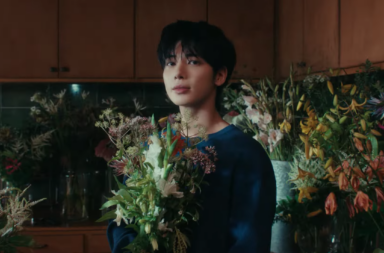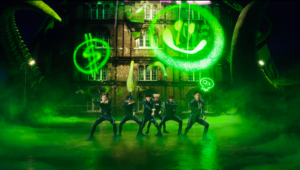
The joy of being a self-proclaimed mid-level K-pop stan is that there is always so much more to find in this genre. Sometimes it misses and sometimes it hits, and when it’s the latter, it is extremely exciting. I feel like that has happened again with the wonderful ONF’s latest song, “Goosebumps”, a confident electro stomper with the MV to back it up.
ONF made recent headlines as the first K-pop boy group to enlist together (minus Japanese member U), a bold and unique move that signals a strong sense of commitment and loyalty to their group and concept. But, away from this flashy headline, ONF have been quietly building an intricate MV universe, pairing this with a strong discography that showcases their individual talents. As a finale to the first stage of their career, “Goosebumps” is a worthy addition to that cannon.
The general mise en scène of this MV is similar to much of their back catalogue: brightly-coloured, glitchy cyberpunk. The backdrops range from neon green computer grids, through to the façade of a huge Victorian house, futuristic cityscapes, space, and even simple blank sound stages. The constant mixing in of frames with the ONF logo, song title, graffiti scribbles, and indecipherable text add a nice touch to a video format that is pretty common in fourth-generation boy group MVs. They also feed into the mythology that the group has carefully curated around androids, time travel, and other science-fiction based concepts that I won’t pretend to fully comprehend yet.
Whilst I admit that I don’t understand the ONF universe (I’m new to it, and, from what I can see, it’s particularly dense), I think that a good test of any K-pop song or MV is whether it holds up without the viewer understanding it. Groups like Aespa have tried with mixed results in this regard, but “Goosebumps” is successful, largely because the nods to the wider universe remain just that, without overwhelming the entire production.
Beginning with a wide shot of robot soldiers and drones pointing their guns towards a dancing E-Tion on a screen, we quickly flip to a tightly danced soundstage sequence. The moment isn’t overdrawn; it’s something that fans can add to their theories, but more casual listeners can also just see it as a unique opener. There are a lot of these touches; J-Us riding through skyscrapers, and possibly a wormhole, on a hoverboard; Wyatt being chased by an army of drones before leaping off a striped precipice into the computerised city below; and a huge cube floating in the air, connected by wires, finishing the MV. There is undoubtedly meaning and story behind these moments (the cube, for instance, may well be Pandora’s Box), but they are peppered lightly throughout the MV, rather than overwhelming it.

Another factor that makes these nods to the greater universe work so well is the well-executed cinematography. K-pop is normally a genre with beautifully clear and high-definition imagery, and this MV is no different. But great care has clearly been taken in the staging here, to give it a really poetic edge. In one scene, Hyojin falls through glass into a pitch-black nothingness are played in slow-motion, allowing the contrast between the light from where he came and the dark he has crashed into to show itself all the more starkly. The glittering shards of glass also float beautifully as they break. Throughout the MV, we are treated to moments like this, and again, they add as much for a casual viewer as they do for the fans.
The most striking visual moment is a scene shot in black and white, one that matches note-perfectly with the music of the song. Transitioning straight from the frenetic, bright dance sequence of the chorus, the music pauses completely as we cut to Wyatt, standing calmly as he is surrounded by doubles of Hyojin aiming a gun at him. The scene is a stark contrast, not simply because of the move from colour to black and white, but also because of the change of pace.
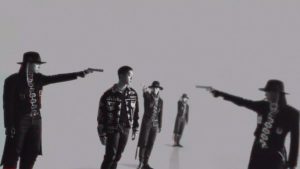
The MV moves from a fast-paced, multiple-cut sequence, as we would expect from choreography scenes, to slow, lingering shots. It’s a masterfully attention-grabbing transition, even more so as it mirrors the music. The chorus’ refrain is largely just a repeat of “Goosebumps”, fast and staccato like bullets. But in this second verse section, the rhythm slows down to allow the snarling synth to crawl to the fore. It’s also the perfect point to utilise Wyatt’s famously deep vocals, and it all fits together here like a Swiss watch.
This expert matching of the MV’s pace to that of the song is its biggest strength throughout. We have the fast cuts and busy visuals when we need them (largely in the dance-heavy sections), and longer, lingering sequences to highlight each members’ storylines, or unique moments in the song itself. During the bridge section, where the members sing together before the phrase “lights on” gets its pitch turned as high as it can go, the shots are notably longer.
A wire flower blooms from a giant robot hand, a member’s face is obscured by smoke as he stands in front of several screens, and E-Tion picks a flower on the moon as a giant robot planet looms behind him. Each scene is given enough time to sink in, for the details to be truly taken in and savoured. It also fits the rhythm of the song neatly and completely: in this moment, when the song is building to a climax, it paces the shots slowly before the final dance break.
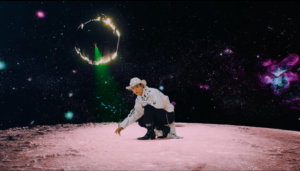
This pacing in the MV also echoes a similar approach to the lyrics. Much as there is a lot of action here, so too do the lyrics speak of shouting, tangling, running, and breaking. But the actions the members sing of are not always breakneck:
What’s this feeling you spread deep in my heart
Goose goose goose goose goosebumps
You seep into me the moment I flinch and move me
These deliberately slow actions of “spreading” and “seeping” appear at several points in the song, matched by longer shots in the MV. For instance, this last line is sung as Wyatt jumps from the precipice in slow-motion. The layers of visuals, lyrics, and music all blend together perfectly, as the underlying synth is still swirling rather than pulsing at this point.
The contrasts between the fast and the slow feed into the lore that ONF have created regarding opposites. We can see these contrasts throughout the song and MV, such as in the lines quoted above, where the middle line comes fast like gunfire, while the other two are given more time. Two of the main dance outfit choices are all black and all white, similar to the styling in their “Ugly Dance” MV. There is also a lot of contrast in the lighting of the MV, with neons used throughout to stand out starkly against pitch black backdrops. And of course, there’s the brief move from colour to black and white. This too works to emphasise the lyrics, where they sing of oppositions such as dreams and reality, night and day, and differences temperature.
It digs in deeply, the cold air attacks me
Let’s get hotter, let’s just endure this much and go
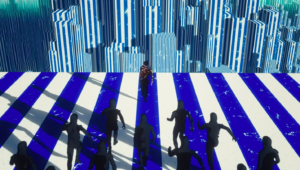
Again, these contrasts do not overpower the song or the MV. Instead, they are utilised subtly to create a song that excites with its rhythms, and an MV that doesn’t let you know where it will go.
Ultimately, “Goosebumps” is an entertaining visual and auditory experience. But its greatest strength comes in its understanding of how to layer both of these experiences together, and create an MV that truly embodies the song it is presenting. This is not a series of gimmicks or glorified fashion shots, but concepts being thought out and played with. As a parting gift for their fans before enlistment, ONF have delivered a fun experience, a well-structured song, and a continuation of their lore that is intricate without being distracting.
(YouTube [1]. Lyrics via Zaty Farhani. Images via WM Entertainment.)


